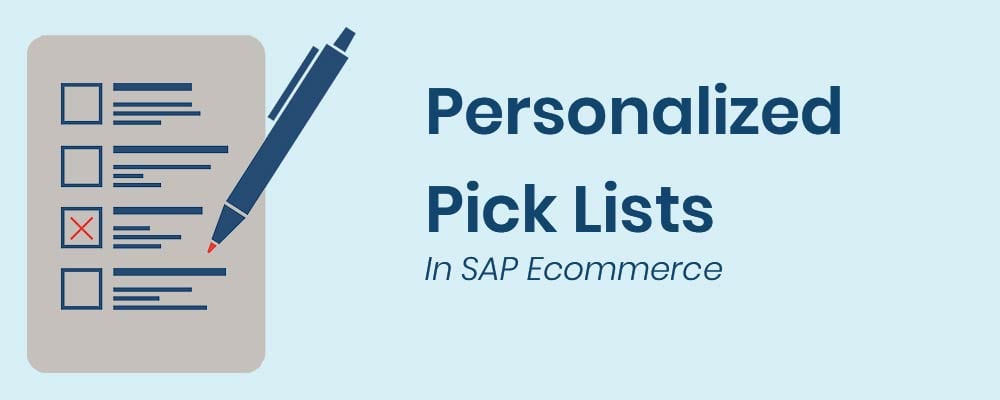Share
Author
George Anderson
Share
Personalized Product Lists in SAP Ecommerce
In 11 years of implementing SAP ecommerce, one lesson stands out for us: the fact that every client’s business is unique. This stood out for us recently when a client needed the capacity to offer template orders in Corevist Commerce. This is the story of what we did to transition the client’s business process from their legacy ecommerce platform to Corevist. Let’s dive in!
The Business Case: Distributors needed to build orders with lowest possible freight charges
Our client chose Corevist Commerce to replace SAP Web Channel Experience Management (WCEM). In their legacy WCEM system, the client had a solution in place that would allow distributors to structure their orders, based on plant of origin, to fill up a truckload and thus get the lowest possible freight charge.
To facilitate this, the client had built a WCEM order template, by sourcing plant, for each of their distributors. When the distributor went to place an order, they would pull one of these order templates, which showed them a list of products available from a specific plant. Using the order template as a guide, the distributor could build an order so it filled up a truckload from the plant in question. This would allow them to save on freight charges.
This solution was workable, but it had a few problems in WCEM.
- WCEM couldn’t display weight, whether by line item or order total. The customer couldn’t tell when they were getting close to a truckload. They had to call Customer Service to run the weight numbers and see how close the order was to filling up a truckload.
- Data for the order templates was static, maintained separately from SAP. If a material was retired, or new materials were offered for sale, someone had to go in and modify each and every template.
- Order templates weren’t only differentiated by distributor and plant, but also by ship-to. One distributor could have up to 15 ship-tos all associated with a single plant. Multiply that by plants, then by distributors, and you see the problem—the proliferation of order templates was nearly unmanageable for the client’s internal team.
When the client came to us to replace WCEM, they wanted to replicate this order template workflow so distributors could continue getting the best value on freight charges.
Here’s how we solved the problem.
Our Solution, Part 1: Personalized pick-list in Corevist Commerce, using live SAP data
The client already had a piece of data in SAP that contained the lists of product associations by distributor. This list in SAP was fed by the CMIR (customer material info record). It also had the plant codes on it indicating where each product was produced. Since the client had already invested in this functionality in SAP, the best value for them would be to leverage this data in Corevist Commerce.
That’s exactly what we did. We extended that data to the web with a personalized, user-friendly pick list. This pick list is sortable by plant or material number.
Now, when a customer goes in to place an order, they can click a button and all products they can order for that ship-to appear dynamically based on a real-time call to SAP. As long as SAP is up to date, the personalized picklist in Corevist Commerce is up to date, too. No one has to go into the ecommerce solution to update the products that are available for the customer to order.
Our Solution, Part 2: Line item weight and order weight displayed in Corevist Cart
In the spirit of 100% self-service, we didn’t stop with the personalized pick list. We had the capability to display line item weight and total order weight in Corevist Commerce—so why not do it? That way, the client’s customers wouldn’t have to call Customer Service to find out if their order was approaching a full truckload. They could see it in real time, right within the ecommerce store.
That’s exactly what we provided.
Now, as the customer builds an order based on plant selection, we show them what the line item weight is (straight from the material’s SAP record), and the total order weight. They can see if they’re approaching a full truckload, and they can swap out products to see what combination of products gets them to a truckload most efficiently.
The Results: Seamless, personalized customer experience
Now the client’s customers can place the best possible orders for their business. Corevist Commerce handles the complexity of the personalized pick lists and order weight and gives customers real-time visibility into the freight impact of their order as they create it. The result is reduced friction in the ordering process and increased transparency for customers. It’s a win-win.
Moving forward: FREE case study
Wondering what SAP-integrated ecommerce looks like in real life? Download this case study on LORD Corporation. You’ll learn how this industrial manufacturer launched Corevist Commerce, fully integrated to SAP, and avoided data duplication issues.
[want_more title=”Learn more” subtitle=”FREE Case study: LORD Corporation” description=”Learn how LORD launched ecommerce that reflects their SAP system in real time.” button_text=”Download Now” button_link=”https://www.corevist.com/lord/” button_class=”btn btn-primary lord-case-study” title2=”See it for yourself” subtitle2=”Talk to us” description2=”Curious what Corevist Commerce can do for you? Let us show you a personalized demo. You’ll see ecommerce with real-time SAP data.” button_text2=”Schedule Demo” button_link2=”https://www.corevist.com/demo/” button_class2=”demo-popup”]







